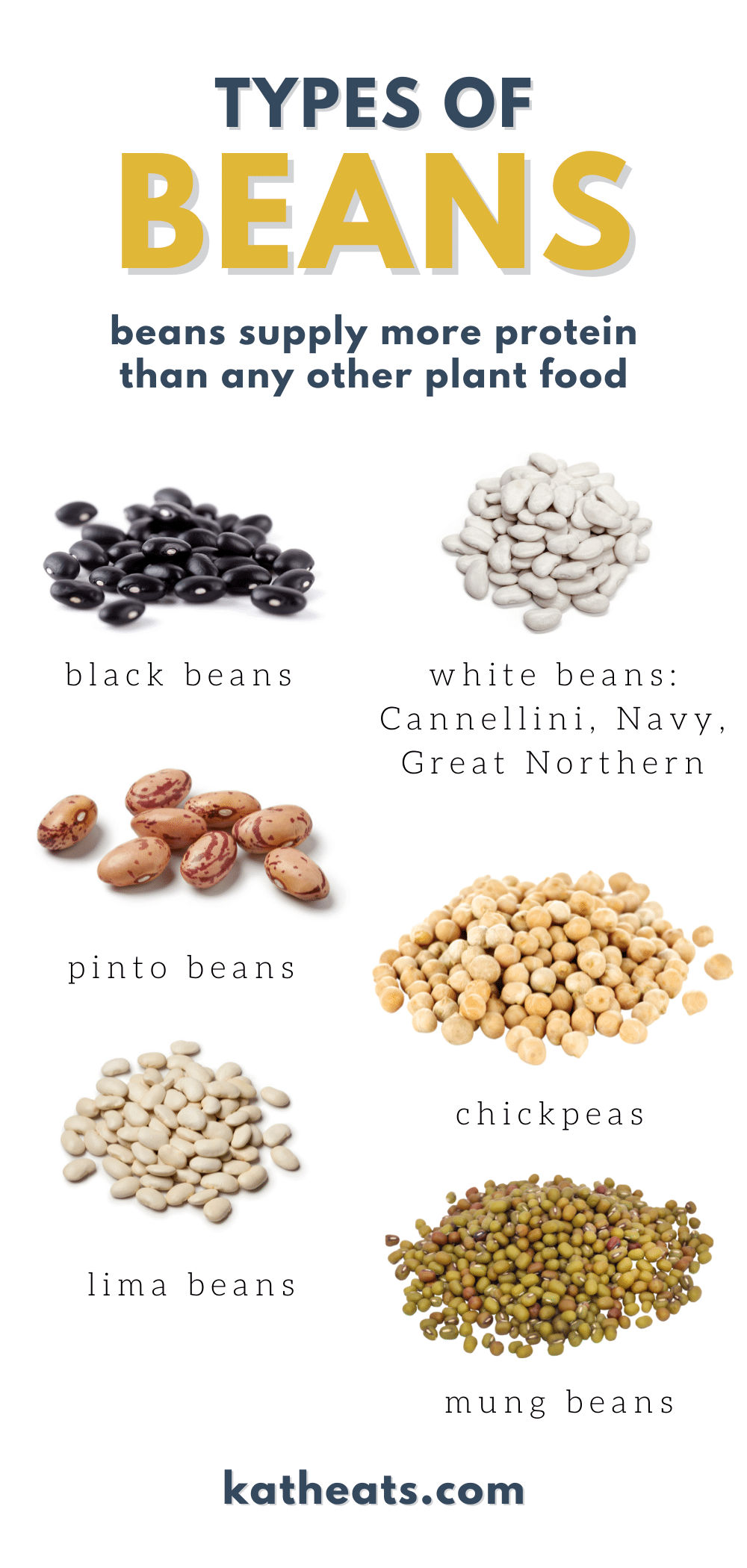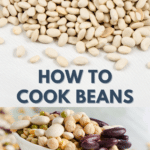I’m answering all your questions about how to cook beans and enjoy them! From soaking to storing to cooking and nutrition, here’s everything you need to know about beans.
How To Cook Beans + Our Favorite Bean Recipes
Beans, beans, the magical fruit. The more you eat, the more… you know the rest!
What’s not to love about beans? They are so versatile and incredibly healthy! Beans should be included in your meal planning each week. That’s my goal! Whether they’re mixed into a hearty chili or soup, served as dip (like this Easy Black Bean & Corn Dip) with my favorite chips, or enjoyed as a vegetarian burger hot off the grill, there are many ways to enjoy them that don’t involve eating them plain.
A Vegetarian Staple
Beans are typically a staple in vegetarian-friendly recipes and diets because of their versatility and high protein content.
Beans are a great nutritious finger food for toddlers, especially one who doesn’t like meat. Birch has never been a big meat eater, and we’ve tried incorporating beans into some sauces for him.
The combination of beans and rice creates a complete protein. Alone, beans and rice lack certain essential amino acids. However, when they’re eaten together, each contributes what the other is missing to form a complete protein.
Now that we have a basic understanding that beans are a nutritious food and versatile for diets across the board, let’s dive into some frequently asked questions about these legumes. If you’ve ever been intimated by cooking dried beans, or want to add a few new legume recipes to your weekly meals, here are some tips!
Bean FAQs
Beans are seeds from the Fabaceae family, commonly known as the legume, pea, or bean family. You may also hear them referred to as “pulses.” They are an affordable source of protein, fiber, iron, and vitamins that offer many health benefits.
There are many types of beans, but some you might be most familiar with include: black beans, Great Northern beans, pinto beans, chickpeas or garbanzo beans, lima beans, and edamame.

Health Benefits of Beans
Beans are rich in complex carbohydrates, low-fat protein, fiber, B vitamins, and minerals.
Beans are partially rich in soluble fibers which is known to help reduce the risk of heart disease by lowering “bad” cholesterol. The insoluble fiber in beans helps speed up the passage of food through our digestive tract, helping with regularity. The ample fiber content in beans is why you may feel full after eating a small serving.
Beans are also an excelled source of low-fat plant protein without containing saturated fat and cholesterol found in animal protein. While all beans are a great source of protein, soybeans are the only bean that are a complete protein on their own. Combining beans in a dish with grains (like rice) provides a complete set of amino acids.
While a good source of many minerals, beans are particularly high in iron. Large lima beans are among those highest in iron – what do ya know! (I personally LOVE lima beans! Probably because in the south they’re also known as butter beans.)
source: Wellness Foods A-Z
What makes beans gas-inducing?
Oligosaccharides. Say what? Oligosaccharides are complex carbohydrate (or sugar), found in beans, that our bodies can’t digest well. These complex sugars pass undigested into the large intestine, where they are fermented into gas. When they travel to the lower part of our digestive tract, they ferment… and fermentation produces gas. Lovely.
Dried vs. Canned Beans
- Good: Canned beans are convenient and great for when you’re in a hurry.
- Better: Soak dried beans in water for fewer additives and sodium than canned beans.
- Best: Soak dried beans with a neutralizer* for optimal nutrition and digestion.
*What’s a neutralizer?
A neutralizer, simply put, aids in eliminating these sugars that are difficult to digest in the cooked beans.
- non-dairy: raw apple cider vinegar, baking soda, lemon juice, kombu
- dairy: plain whole-milk yogurt, cultured buttermilk, kefir, liquid whey
How To Soak Beans
- Rinse 1 to 2 pounds of beans in a mesh colander and remove any debris.
- Place dried beans in a glass or ceramic bowl. Cover with warm water to cover them, about 3-4 inches of water. Add 2 Tbsp. neutralizer for every 1 cup of beans. Also add salt to the soaking water. The recommended soaking time is 8-10 hours, but you can do a quick soak if you boil the beans first.
Why soak beans?
Soaking beans with a neutralizer before cooking makes them easier on the digestive system (a.k.a. less tooting!), the nutrients easier to absorb, and most importantly, shortens the cooking time.
Pro tip: Soak overnight and the beans will be ready to cook in the morning.
Should you salt the bean soaking water?
Yes! Adding salt to the soaking water (a technique called “brining”) can actually help beans cook up creamier and more evenly seasoned. This can improve texture by helping beans keep their shape, enhances flavor since beans absorb a little salt, and reduces bursting of beans by strengthening their skin.
How To Cook Beans
Cooking 1 to 2 pounds of dried beans at a time is manageable and ensures they cook evenly. A large pot can handle this amount without overcrowding.
1. Rinse – Rinse the soaked beans.
2. Cover – Place beans in a large pot or dutch oven. Cover with water 2 inches above the beans.
3. Simmer – Bring beans to a boil, reduce heat to simmer, cover the pot and cook until done (cooking time varies per type of bean).
4. Season – For added nutrition and digestibility, toss in a strip of kombu (dried seaweed); you can add spices of your choice here, too, like cumin, turmeric, and coriander.
Ways to add flavor while cooking beans:
1. Use Aromatics
Add the holy trinity onions, celery, and carrots and/or garlic to the cooking water for flavored beans. You can keep them whole, split in a few large pieces or chop into small pieces for more of a stew.
2. Add Herbs and Spices
- Great herbs for beans are bay leaves, thyme, rosemary, or oregano.
- For a bit of warmth, try smoked paprika, cumin or red pepper flakes for a hint of spice.
3. Use Broth
Instead of plain water, use broth as your bean cooking liquid (vegetable, chicken, or beef) for richer taste. Note the salt content though!
How To Store Beans
- Store dried beans in a glass jar in a cool, dark place for up to one year.
- Store cooked beans in a tightly sealed container in the refrigerator for 3 days, or several months in the freezer.
5 Healthy & Delicious Bean Recipes
1. Orange Dill Bean Salad
The beans provide protein, fiber and starch; cucumber and red pepper satisfy vegetable cravings; dill and orange bring bright flavor; and ricotta adds a salty punch.

2. Easy Chicken & Bean Bake
A KERF classic – the chicken and bean bake! It’s easy to assemble in 15 minutes and bake for an hour. This casserole features three kinds of beans (two canned, one fresh) plus fresh herbs and tasty chicken all baked into one dish. The chicken flavors all the cups of cooked beans underneath!

3. Tropical Bean Salad
This tropical bean salad will bring a little sunshine to your day. With kiwi and pineapple for a burst of flavor, broccoli slaw and black beans are the base of a healthy lunch or side dish. Add coconut flakes on top for an extra special crunch!

4. Homemade Bean Burgers
I used to make these all the time when I had nothing else to eat for lunch. I always had a can of beans! The easiest burgers you’ll ever make full of plant protein. Serve them in a traditional hamburger bun, or serve on top of a salad. And if you’re in the mid-Atlantic, look for No Bull Burgers in the frozen section which are made from lentils and very similar!

5. Easy Slow Cooker Black Beans
An easy recipe for a big pot of black beans that you can enjoy in meals all week long!

Do you have any favorite bean recipes/ways to enjoy beans?






Kathryn says
Great topic, Kath!
I experimented during the pandemic with all beans.
What I found was dried limas soaking for 4-5 days I was able to cook on the stove. All the other beans soaked for 4-5 days and even cooked for 2-3 days just do not cook. I’m thinking you need an instant pot or pressure cooker which I don’t have..
Lentils are a breeze too but that’s as far as it goes.
Might have to invest in instapot .
Have a good weekend.
K~
Elisabeth says
Do you have hard water, by chance? If you do, the magnesium and calcium in the water can actually keep dried beans from ever fully cooking (no matter the method or soak time).
Jennifer says
We make dried beans on occasion but never knew about the neutralizer. I love beans but hate the way they mess up my digestion for days after.
Next time, I’ll try the neutralizer, too. Thanks so much for sharing. 🙂
Laura says
I had no idea about the neutralizer for beans! I get the worst toots after eating beans. I’m going to give it a try next time we make them!